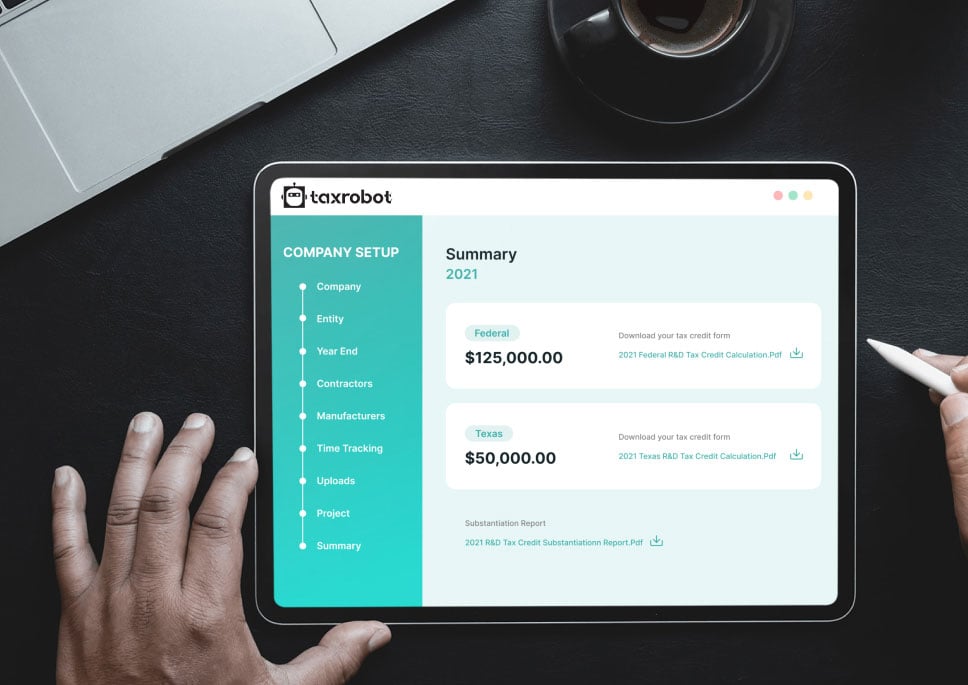Oregon R&D Tax Credit
Maximize your State Credits today!
Put the R&D tax credit process on autopilot.
Trusted By:








Oregon R&D Tax Credits
Discover your eligibility for Oregon R&D tax credits and supercharge your enterprise.
Introducing TaxRobot's AI-Powered R&D Tax Software in Oklahoma
TaxRobot uses innovative artificial intelligence technology to streamline claiming R&D tax credits. Our intelligent software will guide you through three easy steps:
- Provide Your Information
- Link Your Systems
- Receive Your Refund
The R&D Tax Credit and Its Importance
The R&D tax credit is a reward that encourages companies from different industries to invest in innovation within the United States.
It was first introduced in 1981 as part of the Economic Recovery Tax Act and has remained a component of the U.S. Tax code ever since, fostering technological progress and economic development. It is essential for businesses of all scales to grasp the significance of the R&D tax credit and its implications.
Here’s why it matters:
Financial Benefit
One of the advantages of the R&D tax credit is the opportunity for significant financial savings. This credit has the potential to greatly decrease a company’s income tax obligations. For companies that are generating profits, these savings can be highly beneficial for their position.
Encourages Innovation
By providing a tax credit for research and development endeavors, the government encourages businesses to undertake projects that they may otherwise deem too risky or expensive. It fosters an environment of creativity and advancement, motivating companies to create products, improve existing processes, and contribute to progress.
Competitive Advantage
In today’s interconnected world, staying ahead of the competition requires businesses to innovate. To maintain their edge, U.S. companies can participate in activities that grant them access to the R&D tax credit. This will help offset the expenses related to their innovation initiatives.
By making it more affordable for businesses to invest in research and development, this credit enables them to keep up with the evolving market landscape and stay one step ahead of their rivals.
Boosts Economy
The R&D tax credit is not only beneficial for businesses, but it also has a positive impact on the overall economy. By incentivizing companies to invest in research and development, it encourages job creation, enhances productivity, and fosters advancements that can lead to the emergence of industries and economic opportunities.
Contact Our Experts at TaxRobot for R&D Tax Credit Consulting in Oregon
Navigating the complexities of the R&D tax credit process can be daunting. That’s why our team at TaxRobot is here to simplify the journey for you. Our company provides consulting services for R&D tax credits. With the help of our software and a team of tax professionals, we aim to assist you in optimizing your claims to the fullest extent possible.
You Don’t Have to Do It Alone
If you have any inquiries regarding eligibility, require assistance in understanding which expenses qualify, or need help preparing for an audit, our team of experts is here to support you. We have an understanding of the complexities surrounding the R&D tax credit environment. We stay current with IRS regulations and guidelines to ensure your compliance at all times.
Get Started Today
Getting started with us is straightforward. Simply fill out the form on our contact page. During our initial consultation, we’ll walk you through our process and take the time to understand your business’s unique needs. This personalized approach will ensure that you receive the maximum refund possible.
Don’t miss out on the opportunity to reduce your tax liability and boost your cash flow. Contact our experts at TaxRobot today and let us help you get the most from your R&D tax credits.
Take a sneak peak

- Limited Time Offer
- Simple Onboarding
- Easy to Use
R&D Tax Credits FAQs
The four-part test as outlined in the Internal Revenue Code is used to determine qualified R&D activity.
The Four-Part Test
1). New Or Improved Business Component
Creation of a new product, process, formula, invention, software, or technique; or improving the performance, functionality, quality, or reliability of existing business component.
- Construction of new buildings or renovation of existing buildings
- Invention of a software application
- Manufacturing of a new product or the improvement of the production process for an existing product
- Creation of design documentation
2). Technological In Nature
The activity fundamentally relies on principles of the physical or biological sciences, engineering, or computer science. A taxpayer does not need to obtain information that exceeds, expands or refines the common knowledge of skilled professionals in a particular field.
- Physics (relationship between mass, density and volume; loading as the
result of gravitational attraction) - Engineering (mechanical, electrical, civil, chemical)
- Computer science (theory of computation and design of computational systems)
3). Elimination Of Uncertainty
Uncertainty exists if the information available to the taxpayer does not establish the capability or method for developing or improving the business component, or the appropriate design of the business component.
- The capability of a manufacturer to create a part within the specified tolerances
- The appropriate method of overcoming unsuitable soil conditions during construction
- The appropriate software design to meet quality and volatility requirements
4). Process Of Experimentation
A process designed to evaluate one or more alternatives to achieve a result where the capability or method of achieving that result, or the appropriate design of that result, is uncertain as of the beginning of the taxpayer’s research activities.
- Systematic process of trial and error
- Evaluating alternative means and methods
- Computer modeling or simulation Prototyping Testing
The R&D tax credit is one of the most misunderstood tax incentives available. Considering the myriad of industries and activities that legally qualify for the credit, the term “research and development” is a misnomer. Additionally, the R&D tax credit requires specialized knowledge and technology to identify and calculate the incentive properly.
Companies of various industries are unaware that they are eligible to claim the R&D tax credit. Under the Internal Revenue Code’s definition of R&D, many common activities qualify. You can get tax benefits for industries including software, technology, architecture, engineering, construction, manufacturing, and more.
The R&D tax credit can be claimed for all open tax years. Generally, open tax years include the prior three tax years due to the statute of limitations period. In certain circumstances, the law allows businesses to claim the R&D tax credit for an extended period of time. It is common for companies to amend previous tax years to claim this benefit and reduce the maximum amount of tax liability.
Partnerships and S corporations must file this form to claim the credit. The credit will flow from the Form 6765, to the Schedule K-1, to the Form 3800 on the individual’s tax return. For individuals receiving this credit that have ownership interest in a partnership or S corporation, Form 6765 is not required on the individual return.
Individuals claiming this credit can report the credit directly on Form 3800, General Business Credit if their only source for the credit is a partnership, S corporation, estate, or trust. Otherwise, Form 6765 must be filed with the individual’s tax return (e.g. sole proprietorship).
For tax years prior to 2016, the credit can be used to reduce the taxpayer’s regular tax liability down to the tentative minimum tax. The credit cannot be used to offset alternative minimum tax. Beginning in tax year 2016, eligible small businesses have expanded utilization for the credit. For these eligible small businesses, the regular tax liability can offset alternative minimum tax using the “25/25” rule.
What our customers have to say
I highly recommend TaxRobot to anyone considering an R&D Tax Credit software to complete their analysis.

We decided to switch to TaxRobot… Best decision we’ve ever made. More affordable, and less complicated.

I couldn’t believe how easy it was! In under an hour, we saved enough money to hire a new employee.
